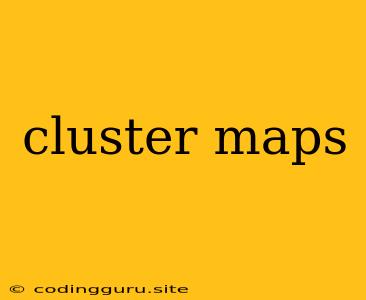What are Cluster Maps and Why Are They Useful?
Cluster maps are a powerful visualization tool that helps simplify and organize large datasets by grouping similar points together. This is particularly useful when dealing with large amounts of data that would be overwhelming if displayed individually. Think of it like organizing a cluttered room; clustering helps to create order out of chaos, making the information easier to understand and interpret.
But how do cluster maps work? The basic idea is to group nearby points on a map based on a defined distance or proximity threshold. This creates clusters, visually representing areas of high data density. These clusters can then be further explored to reveal patterns, trends, and insights within the data.
Why are cluster maps so useful?
- Reduced Visual Clutter: Cluster maps effectively reduce visual clutter by condensing numerous individual points into meaningful groups, allowing you to focus on the overall distribution patterns instead of being overwhelmed by individual data points.
- Improved Data Exploration: By presenting data in clustered format, cluster maps facilitate the exploration of spatial patterns, such as identifying areas with high concentrations of a specific phenomenon.
- Enhanced Insights: Cluster maps offer a unique perspective on data, allowing you to identify hotspots, outliers, and trends that might be missed when viewing data in a traditional, individual-point format.
How are cluster maps used in real-world applications?
Cluster maps find applications in a wide range of fields, including:
- Business: Identifying customer demographics, analyzing sales patterns, and optimizing delivery routes.
- Healthcare: Analyzing disease outbreaks, identifying high-risk areas, and tracking patient flow.
- Urban Planning: Analyzing population density, identifying crime hotspots, and planning infrastructure development.
- Environmental Science: Mapping species distribution, analyzing pollution levels, and monitoring natural disasters.
Creating your own cluster maps:
There are numerous tools and platforms available for creating cluster maps. Some popular options include:
- Google Maps: Offers built-in clustering capabilities for marker data.
- Leaflet: A popular JavaScript library for creating interactive maps, including clustering functionality.
- Mapbox: A platform for creating and customizing maps with advanced clustering options.
Tips for using cluster maps effectively:
- Choose an appropriate clustering algorithm: Different algorithms are available, each with its own strengths and weaknesses. Consider the specific characteristics of your data and the desired level of granularity.
- Define a meaningful clustering threshold: This value determines the size of the clusters and can influence the insights you gain. Experiment with different thresholds to find the optimal setting for your analysis.
- Use effective visual cues: Color, size, and shape can be used to differentiate between clusters and emphasize specific patterns.
- Consider zooming and panning: Cluster maps can be interactive, allowing users to zoom in and out to explore specific areas in greater detail.
In conclusion, cluster maps are a powerful and versatile tool for visualizing and analyzing spatial data. By grouping similar points together, cluster maps provide a clear and concise representation of data distribution, revealing patterns and insights that would otherwise be hidden. This visual representation makes it easier to understand complex data, identify trends, and make informed decisions.
